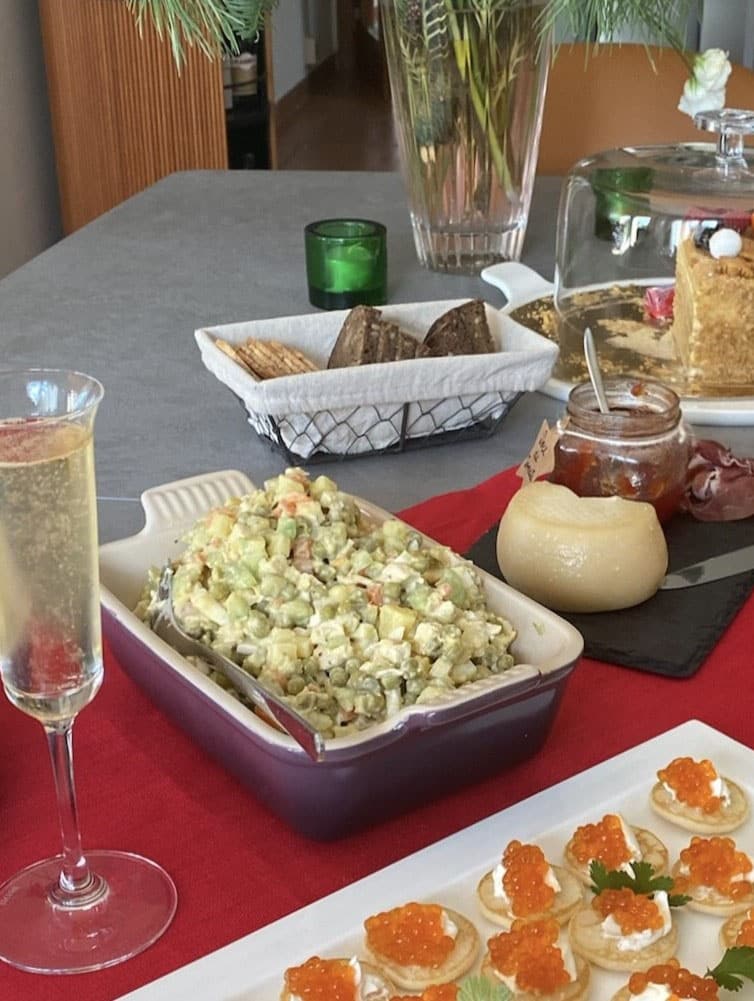Salads are an essential part of any diet. However, an idea of what constitutes a salad is often laden with local peculiarities.
For instance, in a Mediterranean culture, the word salad most traditionally evokes an image of a bowl of leafy greens partnered with vegetables, fruits and nuts, and dressed with a zesty vinaigrette.
In Asia, it is commonly a plate of shaved vegetables with a flavoured soya dressing. In the post-Soviet space, ordering a salad more often than not results in a protein bomb, such as meats, poultry or fish, served with boiled or pickled vegetables and a mayonnaise sauce.
Such a surprising concoction of ingredients is a reflection of culinary habits acquired over the centuries. During the 19th century tsarist Russia, all things French were considered the height of sophistication, therefore, cuisine using copious amounts of Sauce Provençal was perceived as imperial and noble.
In this context, the term Sauce Provençal actually refers to mayonnaise as it used to be made exclusively with oil from Provence.
Then, there was the Soviet era that hailed root vegetables as well as pickled goods for the pragmatic reasons of ease of growing, harvesting and storing.
Over time, cookbooks were written capturing endless combinations of the old and new culinary epochs, with one certain recipe celebrated at all times and in all instances. I am speaking of the timeless classic that is quite possibly the most well-known Russian culinary export – Salad Olivier, aka Russian Salad.
Its history goes back to the 1860s to a restauranteur Lucian Olivier. Born in Russia into a Franco-Belgian family as Nikolai Olivier, he later changed his name to Lucian. It proved more lucrative for running a French-style restaurant in the middle of Moscow. His restaurant was called Hermitage.
Serving the local merchants and traders, the restaurant attempted to combine French sophistication with the local ingredients. Thus, the original recipe titled ‘Game Mayonnaise’ combined wild grouse, chicken aspic and potatoes with capers, lobster tails and the glorious Sauce Provençal. Ingredients were presented on the plate in separate heaps and the whole dish was decorated with pieces of egg, meant for aesthetic purposes only.
The dish quickly became popular amongst the Muscovite public, inviting an assortment of visitors to savour it. Once, having just served his masterpiece to an eager customer, the chef observed him mixing all the ingredients together and consuming the mix with the glee. “Mais, ce n’est pas possible”. To show his disdain for such barbaric behaviour, the following day, chef Olivier premixed his salad himself and served it with the dollop of mayo. Ironically, the barbaric version surpassed the original one in its popularity and, thence, Salad Olivier was born.
Escaping the Revolution, Russian immigrants took the recipe worldwide, at times confusing its Russian and French origins.
Generally, in Europe, the salad is known as Russian Salad. In the Netherlands, it is known as Huzarensalade (hussars salad), and, in the Balkans, it is called Ruska salata or Francuska salata; in Mexico and Spain, it is an Ensalada (or ensaladilla) Rusa. Interestingly, in Scandinavia, it is sometimes called Italiensk Salat (Italian salad), which acknowledges the borrowing of the recipe from the Northen Italy, where it is known, yet again, as Insalata Russa.
The Soviet era brought some alterations to the classical recipe. Grouse and lobster, positively bourgeois, were substituted with chicken or Doktorskaya kolbasa, a type of cooked sausage similar to Mortadella. Other additions also include boiled carrots, canned peas and a fresh cucumber.
Yet, regardless of the version, Salad Olivier has stood the test of time. In that part of the world, Salad Olivier on the table is akin to Dostoyevsky in literature. One might not necessarily love it but would never speak badly of it in public*.
SALAD OLIVIER
Ingredients
- 3 eggs, hard boiled
- 1 large potato, boiled in a jacket
- 1 medium carrot, boiled in a jacket
- 1 medium fresh cucumber, peeled with core removed
- 1 medium shallot or sweet onion
- 5 small cornichons
- 120g green peas, fresh or canned
- 200g of chicken (or beef, or salmon), cooked
- 3 tbsp mayonnaise
- 1 tbsp soured cream
- half a lemon
- salt and white pepper to taste
- dill, a few twigs
Instructions
- Peel cooled potatoes, carrots and eggs.
- Dice eggs, potatoes, carrots, cucumber and proteins of choice into small cubes, 5-6mm, and place them into a mixing bowl.
- Dice cornichons and shallots into very small cubes, 3mm, and add them to the mixture.
- Add green peas, and dress with a mix of mayonnaise and soured cream.
- Season with salt and pepper. Let the salad sit for 30 minutes to release flavours.
- Check the seasoning and adjust salt and acidity. Lemon juice can help with the latter.
- Serve using food rings, or in a martini glass topped with some dill.
- Inspired by reading Pavel and Olga Syutkin in the Moscow Times.
By Dr. Irina Mikhailava
|| features@algarveresident.com
Dr. Irina Mikhailava, a chef and a good food champion, happily residing in the Algarve and eating all over the world with an appetite for learning, sharing and writing. Instagram: incompanyoffood




















